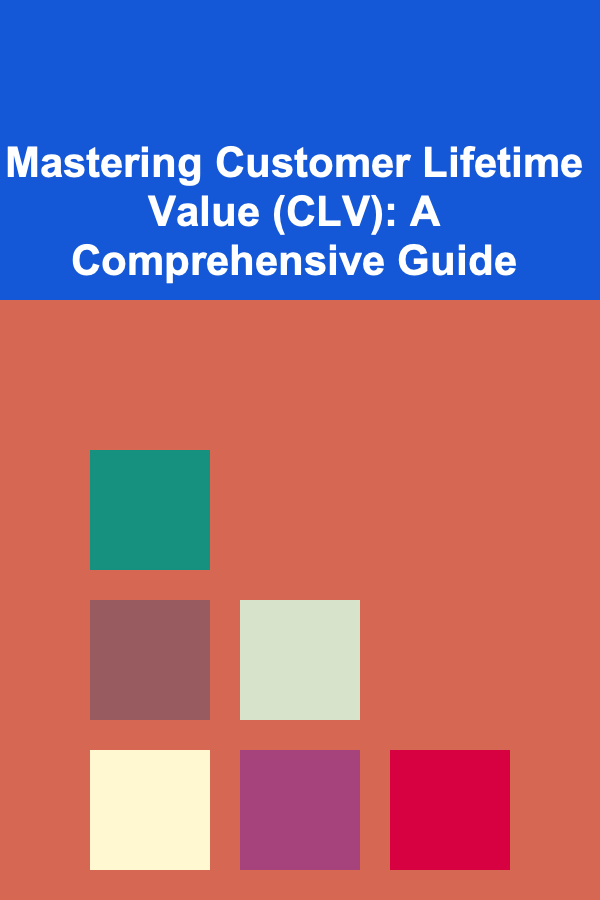
Mastering Customer Lifetime Value (CLV): A Comprehensive Guide
ebook include PDF & Audio bundle (Micro Guide)
$12.99$5.99
Limited Time Offer! Order within the next:

In today's competitive business landscape, acquiring new customers is often more expensive than retaining existing ones. Therefore, understanding and maximizing Customer Lifetime Value (CLV) is crucial for sustainable growth and profitability. CLV represents the total worth of a customer to a business over the entire period of their relationship. It's not just about the initial purchase; it's about the repeat business, loyalty, and advocacy a customer provides over their lifetime.
This comprehensive guide delves into the intricacies of CLV, exploring its significance, calculation methods, strategies for improvement, and potential pitfalls. By understanding and implementing these principles, businesses can make data-driven decisions that foster stronger customer relationships and drive long-term success.
Why Customer Lifetime Value Matters
Understanding CLV provides a multitude of benefits for businesses:
- Strategic Decision Making: CLV informs resource allocation across marketing, sales, and customer service. It helps prioritize efforts towards high-value customers and optimize spending for maximum return.
- Improved Customer Acquisition: By knowing the potential value of a customer, businesses can justify higher acquisition costs, especially in the long run. It allows for more targeted and effective marketing campaigns.
- Enhanced Customer Retention: CLV highlights the importance of retaining existing customers. It encourages businesses to invest in customer satisfaction and loyalty programs to increase customer lifetime.
- Increased Profitability: Focusing on CLV directly contributes to increased profitability. Retained customers are often more profitable than new ones, as they require less marketing and sales effort.
- Product and Service Development: Analyzing the purchasing patterns and preferences of high-value customers provides valuable insights for product development and service improvements. This ensures that offerings are aligned with customer needs and expectations.
- Competitive Advantage: A deep understanding of CLV allows businesses to differentiate themselves from competitors by providing superior customer experiences and building stronger relationships.
Calculating Customer Lifetime Value
There are several methods for calculating CLV, ranging from simple estimations to more complex predictive models. The choice of method depends on the availability of data and the level of accuracy required. Here are some common approaches:
1. Simple Historical CLV
This is the most basic method, focusing on past transactions. It's calculated by summing the gross profit from all past purchases made by a customer.
Formula:
CLV = (Average Purchase Value) x (Number of Purchases)
Example:
A customer made 5 purchases, each with an average value of $50. Their historical CLV is:
CLV = $50 x 5 = $250
Limitations: This method only considers past behavior and doesn't account for future purchases or the time value of money. It's best used as a quick snapshot of existing customer value.
2. Traditional CLV
This method incorporates more factors, including average purchase value, purchase frequency, customer lifespan, and profit margin. It provides a more accurate representation of a customer's potential value.
Formula:
CLV = (Average Purchase Value x Purchase Frequency) x Customer Lifespan
Adjusted for Profit Margin:
CLV = ((Average Purchase Value x Purchase Frequency) x Customer Lifespan) x Profit Margin
Example:
A customer spends $100 per purchase, makes 2 purchases per year, has an estimated lifespan of 5 years, and the profit margin is 20%.
CLV = (($100 x 2) x 5) x 0.20 = $200
3. Discounted CLV
This is a more sophisticated method that considers the time value of money. It discounts future revenue streams back to their present value using a discount rate. This reflects the fact that money received today is worth more than money received in the future due to factors like inflation and investment opportunities.
Formula:
CLV = ∑ ( (Profit per period) / (1 + Discount Rate)^Period Number )
In simpler terms:
CLV = (Profit in Year 1 / (1 + Discount Rate)^1) + (Profit in Year 2 / (1 + Discount Rate)^2) + ... + (Profit in Year n / (1 + Discount Rate)^n)
Example:
Assume a customer is expected to generate a profit of $50 per year for 3 years, and the discount rate is 10%.
CLV = ($50 / (1 + 0.1)^1) + ($50 / (1 + 0.1)^2) + ($50 / (1 + 0.1)^3)
CLV = ($50 / 1.1) + ($50 / 1.21) + ($50 / 1.331)
CLV = $45.45 + $41.32 + $37.57
CLV ≈ $124.34
Key Considerations for Discounted CLV:
- Discount Rate: Selecting an appropriate discount rate is crucial. It reflects the risk associated with future revenue streams. A higher discount rate implies a higher risk and will result in a lower CLV. Common discount rates range from 8% to 15%, but the specific rate should be tailored to the business and industry.
- Customer Lifespan: Accurately estimating customer lifespan is essential. This can be based on historical data, industry benchmarks, or predictive models.
4. Predictive CLV
This is the most advanced method, utilizing statistical models and machine learning techniques to predict future customer behavior. It considers a wider range of variables, such as demographics, purchase history, browsing behavior, and customer interactions.
Common Predictive Models:
- Regression Models: Used to predict future purchases based on historical data and other relevant variables.
- Survival Analysis: Estimates the probability of a customer remaining active over time.
- Machine Learning Algorithms (e.g., Random Forest, Gradient Boosting): Can handle complex relationships and interactions between variables to predict CLV with greater accuracy.
- RFM (Recency, Frequency, Monetary Value) Analysis: Segmenting customers based on their recent purchases, frequency of purchases, and monetary value to predict future behavior.
- Cohort Analysis: Grouping customers based on their acquisition date to track their behavior and CLV over time. This allows for identifying trends and patterns in customer behavior.
Benefits of Predictive CLV:
- Improved Accuracy: Provides more accurate CLV estimates compared to simpler methods.
- Personalized Marketing: Enables personalized marketing campaigns based on individual customer predictions.
- Proactive Retention: Identifies customers at risk of churn and allows for proactive retention efforts.
Challenges of Predictive CLV:
- Data Requirements: Requires a significant amount of high-quality data.
- Technical Expertise: Requires expertise in data science and statistical modeling.
- Model Maintenance: Models need to be regularly updated and refined to maintain accuracy.
Strategies to Improve Customer Lifetime Value
Once you understand how to calculate CLV, the next step is to implement strategies to improve it. Here are several effective approaches:
1. Enhance Customer Onboarding
The initial customer experience is critical in shaping long-term perceptions. A well-designed onboarding process can significantly impact CLV. This includes:
- Personalized Welcome Messages: Tailor welcome messages based on customer demographics and purchase history.
- Clear Product Information: Provide clear and concise information about products and services.
- Easy-to-Use Tutorials: Offer tutorials and guides to help customers get started quickly.
- Proactive Support: Reach out to customers proactively to offer assistance and address any concerns.
2. Deliver Exceptional Customer Service
Providing outstanding customer service is paramount for building loyalty and increasing CLV. This involves:
- Prompt and Efficient Support: Respond to customer inquiries and resolve issues quickly.
- Personalized Interactions: Treat each customer as an individual and tailor interactions to their specific needs.
- Omnichannel Support: Offer support across multiple channels, such as phone, email, chat, and social media.
- Empowered Customer Service Representatives: Give customer service representatives the authority to resolve issues independently.
3. Foster Customer Loyalty
Loyal customers are more likely to make repeat purchases and recommend your business to others. Implement loyalty programs and initiatives to encourage customer retention:
- Reward Programs: Offer points, discounts, or exclusive benefits to loyal customers.
- Personalized Offers: Send personalized offers based on customer purchase history and preferences.
- Early Access to New Products: Give loyal customers early access to new products or services.
- VIP Treatment: Provide VIP treatment to high-value customers, such as dedicated account managers or priority support.
4. Personalize the Customer Experience
Customers appreciate personalized experiences that cater to their individual needs and preferences. Use data to personalize every interaction:
- Personalized Product Recommendations: Suggest products based on past purchases and browsing history.
- Personalized Email Marketing: Segment email lists and send targeted messages based on customer interests.
- Dynamic Website Content: Customize website content based on customer demographics and behavior.
- Personalized Pricing: Offer personalized pricing based on customer loyalty and purchasing power (use with caution and transparency).
5. Increase Customer Engagement
Engaged customers are more likely to stay loyal and increase their CLV. Implement strategies to keep customers engaged with your brand:
- Content Marketing: Create valuable and engaging content that resonates with your target audience.
- Social Media Engagement: Interact with customers on social media, respond to comments, and run contests.
- Community Building: Create a community where customers can connect with each other and with your brand.
- Surveys and Feedback: Solicit customer feedback and use it to improve your products and services.
6. Upselling and Cross-selling
Increase CLV by encouraging customers to purchase more products or services. This can be achieved through:
- Relevant Product Recommendations: Suggest complementary products that enhance the customer's existing purchases.
- Bundle Offers: Offer discounted prices on bundles of products or services.
- Upgrade Opportunities: Provide opportunities for customers to upgrade to higher-level products or services.
- Personalized Promotions: Tailor promotions to individual customer needs and preferences.
7. Reduce Customer Churn
Reducing churn is crucial for maximizing CLV. Implement strategies to identify and prevent customer attrition:
- Identify At-Risk Customers: Use data to identify customers who are likely to churn.
- Proactive Retention Efforts: Reach out to at-risk customers with personalized offers and support.
- Gather Feedback on Churn Reasons: Understand why customers are leaving and address the underlying issues.
- Improve Customer Satisfaction: Continuously strive to improve customer satisfaction to reduce churn.
8. Optimize Pricing Strategies
Pricing plays a significant role in customer lifetime value. While aggressive discounting can attract new customers, it can also devalue your brand and reduce long-term profitability. Consider these strategies:
- Value-Based Pricing: Price your products or services based on the perceived value they provide to customers.
- Tiered Pricing: Offer different pricing tiers to cater to different customer needs and budgets.
- Dynamic Pricing: Adjust pricing based on market conditions, demand, and customer behavior (use ethically and transparently).
- Subscription Models: Encourage recurring revenue through subscription models that offer convenience and value.
9. Continuously Monitor and Analyze CLV
CLV is not a static metric; it changes over time. Continuously monitor and analyze CLV to identify trends, measure the effectiveness of your strategies, and make data-driven decisions. Use analytics tools and dashboards to track key metrics and identify areas for improvement. Regular reporting and analysis are crucial for optimizing CLV.
Common Pitfalls to Avoid When Calculating and Using CLV
While CLV is a powerful tool, it's important to be aware of its limitations and potential pitfalls:
- Inaccurate Data: Garbage in, garbage out. Inaccurate or incomplete data will lead to inaccurate CLV calculations. Ensure data quality through proper collection, validation, and cleaning processes.
- Ignoring Customer Segmentation: Treating all customers the same can be misleading. Segment customers based on their demographics, behavior, and value to gain a more nuanced understanding of CLV.
- Over-reliance on Historical Data: Past performance is not always indicative of future results. Consider future trends and market changes when calculating CLV.
- Using a Single Calculation Method: Different CLV calculation methods provide different perspectives. Use a combination of methods to gain a more comprehensive understanding.
- Neglecting Marketing Costs: Don't forget to factor in marketing costs when calculating CLV. The true value of a customer is the revenue they generate minus the cost of acquiring and retaining them.
- Ignoring Customer Churn: Failing to account for customer churn can significantly inflate CLV estimates.
- Over-Promising and Under-Delivering: While CLV helps justify acquisition costs, don't overspend to acquire customers if you can't provide the expected value. This can lead to negative word-of-mouth and decreased customer loyalty.
- Focusing Solely on CLV: CLV is important, but it's not the only metric that matters. Also consider customer satisfaction, Net Promoter Score (NPS), and other key performance indicators.
- Lack of Actionable Insights: Calculating CLV is just the first step. The real value comes from using the insights to improve your business processes and customer relationships.
- Ignoring the Impact of External Factors: Market conditions, economic downturns, and competitor actions can all impact CLV. Account for these external factors when making predictions.
Conclusion
Mastering Customer Lifetime Value is an ongoing process that requires a deep understanding of your customers, a commitment to data-driven decision making, and a relentless focus on customer satisfaction. By implementing the strategies outlined in this guide, businesses can build stronger customer relationships, increase profitability, and achieve sustainable growth. CLV is not just a number; it's a philosophy that puts the customer at the heart of your business strategy.
Embrace the principles of CLV, continuously monitor your results, and adapt your strategies as needed. The long-term rewards of a customer-centric approach will far outweigh the initial investment.

How to Keep Toy Organization Fun and Engaging
Read More
How To Safely Use Smart Vehicles
Read More
How to Work with a Marriage Event Planner for an Engagement Party
Read More
How To Speak with Purpose and Intention
Read More
How To Master Inclusive Leadership
Read More
How to Deal with Dating Burnout
Read MoreOther Products

How to Keep Toy Organization Fun and Engaging
Read More
How To Safely Use Smart Vehicles
Read More
How to Work with a Marriage Event Planner for an Engagement Party
Read More
How To Speak with Purpose and Intention
Read More
How To Master Inclusive Leadership
Read More